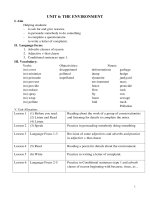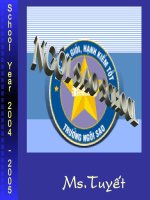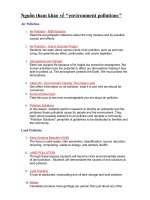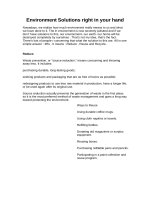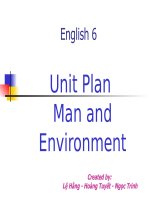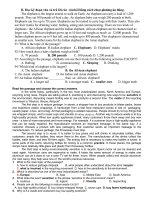Environment pollutions
Bạn đang xem bản rút gọn của tài liệu. Xem và tải ngay bản đầy đủ của tài liệu tại đây (57.93 KB, 3 trang )
Ngu ồn tham khảo v ề “environment pollutions”
Air Pollution
1. Air Pollution - MSN Encarta
Read the encyclopedic reference about the lung menace and its possible
causes and effects.
2. Air Pollution - Use in Schools Project
Students can learn about various kinds of air pollution, such as acid rain,
smog, the greenhouse effect, particulates, and ozone depletion.
3. Atmosphere and Climate
Earth can support life because of its fragile but protective atmosphere. But
human activities have the potential to affect our atmosphere making it less
able to protect us. The atmosphere protects the Earth. We must protect the
atmosphere.
4. Clean Air - Environment Canada: The Green Lane
Site offers information on air pollution, what it is and why we should be
concerned.
5. Environmental Quiz
Take this quiz to see how knowledgeable you are about air pollution.
6. Pollution Solutions
In this lesson, students perform research to identify air pollutants and the
problems these pollutants cause for people and the environment. They
learn about possible solutions to air pollution and develop a community
"Pollution Solutions" pamphlet of guidelines to be distributed to families and
the community.
Land Pollution
7. Keep America Beautiful (KAB)
The focus is solid waste, litter prevention, beautification, source reduction,
recycling, composting, waste-to-energy, and sanitary landfill.
8. LAND POLLUTION
Through these lessons students will become more environmentally aware
of land pollution. Students will demonstrate the causes of and solutions to
land pollution.
9. Land Pollution
A look at pesticides, composting and oil tank storage and land pollution.
10. Waste
Canadians produce more garbage per person than just about any other
country in the world. The average person in Ontario generates a whole
tonne of trash a year! When that much garbage is generated, it creates
problems. It’s time to do our part and make a difference!
11. Water Pollution Begins on the Land
Our activities on the land can affect water quality in our streams, rivers and
coastal waterways. On the farm, eroded soil, fertilizers, and animal wastes
washing off the land can have a profound effect on water quality
downstream. Here are some of the conservation measures that Maryland
farmers use to protect our streams and rivers from sediment and nutrient
pollution.
Noise Pollution
12. Noise Harms Sea Mammals
An article from ABC about how underwater noise pollution may alter the
ocean habitat, and regulations may be needed to protect marine
dwellers.
13. Noise Pollution
A look at noise pollution in relation to hearing loss.
14. Noise Pollution
Explains what noise pollution is, what types of things cause it, as well as
good uses of noise.
Water Pollution
15. Clean Water - Environment Canada: The Green Lane
Site offers information on water pollution, what it is, its causes and why
we should be concerned.
16. Finite Oceans
Finite Oceans examines how humans continue to contaminate the seas
with industrial pollutants and explores alternatives to our current
methods of waste disposal.
17. Groundwater Gross-Out
In this activity, students model the spread of toxic waste into the
groundwater system.
18. Water for Life: Keep the Wild Alive
This guide brings together a set of lessons centered around watersheds,
streams, lakes, wetlands, and oceans and some of the endangered species
that inhabit them. Through these lessons students will learn how animals
and plants living in and near water-based environments depend on each
other and what people can do to protect and preserve these wild places.
19. Water Pollution
There are a wide variety of pollutants that can affect water and the plants
and animals that live in the water. This pollution can be divided into three
groups: chemical pollution, thermal pollution, and ecological pollution.
Since not all pollution is human produced, students need to understand that
there are sometimes natural reasons for some pollution. These activities
will help students' understanding of water pollution and its potential effects
on human and wildlife habitats.
